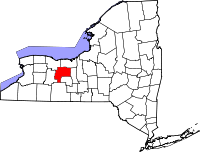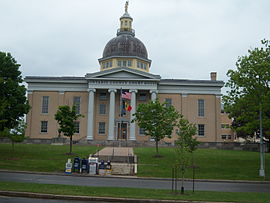- Ontario County, New York
-
Ontario County, New York Ontario County Courthouse in Canandaigua
Seal
Location in the state of New York
New York's location in the U.S.Founded 1789 Seat Canandaigua Area
- Total
- Land
- Water
662 sq mi (1,715 km²)
644 sq mi (1,668 km²)
18 sq mi (47 km²), 2.72%Population
- (2010)
- Density
107,931
168/sq mi (64.7/km²)Website www.co.ontario.ny.us Ontario County is a county located in the U.S. state of New York. The county seat is the City of Canandaigua. The population of Ontario County in the 2010 census was 107,931, up from 100,224 at the 2000 census.
Ontario County is part of the Rochester, NY Metropolitan Statistical Area.
In 2006, Progressive Farmer rated Ontario County as the "Best Place to Live" in the U.S., for its "great schools, low crime, excellent health care" and its proximity to Rochester.
Contents
History
When counties were established in New York State in 1683, the present Ontario County was part of Albany County. This was an enormous county, including the northern part of New York State as well as all of the present State of Vermont and, in theory, extending westward to the Pacific Ocean. This county was reduced in size on July 3, 1766 by the creation of Cumberland County, and further on March 16, 1770 by the creation of Gloucester County, both containing territory now in Vermont.
On March 12, 1772, what was left of Albany County was split into three parts, one remaining under the name Albany County. One of the other pieces, Tryon County, contained the western portion (and thus, since no western boundary was specified, theoretically still extended west to the Pacific). The eastern boundary of Tryon County was approximately five miles west of the present city of Schenectady, and the county included the western part of the Adirondack Mountains and the area west of the West Branch of the Delaware River. The area then designated as Tryon County now includes 37 counties of New York State. The county was named for William Tryon, colonial governor of New York.
In the years prior to 1776, most of the Loyalists in Tryon County fled to Canada. In 1784, following the peace treaty that ended the American Revolutionary War, the name of Tryon County was changed to honor the general, Richard Montgomery, who had captured several places in Canada and died attempting to capture the city of Quebec, replacing the name of the hated British governor. Seth Reed, a Colonel in the Battle of Bunker Hill moved here with his family as a Pioneer between 1787 and 1795. see also Geneva (town), New York[1]
In 1789, Ontario County was split off from Montgomery. The actual area split off from Montgomery County was much larger than the present county, also including the present Allegany, Cattaraugus, Chautauqua, Erie, Genesee, Livingston, Monroe, Niagara, Orleans, Steuben, Wyoming, and Yates Counties, and part of Schuyler and Wayne Counties.
In 1796, Ontario County was reduced in size by the splitting off of Steuben County.
In 1802, Ontario County was reduced in size by the splitting off of Genesee County. The actual area split off from Ontario County was much larger than the present county, also including the present Allegany, Cattaraugus, Chautauqua, Erie, Niagara, Orleans and Wyoming Counties and parts of Livingston and Monroe Counties.
In 1821, portions of Genesee County were combined with portions of Ontario County to create Livingston and Monroe Counties.
In 1823, a portion of Seneca County was combined with a portion of Ontario County to create Wayne County. The same year, a portion of Steuben County was combined with a portion of Ontario County to create Yates County.
Latter Day Saint movement
Latter Day Saint movement founder Joseph Smith, Jr. lived in Manchester in the 1820s on the border with Palmyra and several events in the early history of the movement occurred in Ontario County. Hill Cumorah in Manchester is where Smith is said to have discovered the Golden plates which contained the writings later known as the Book of Mormon. Smith visited the hill each year on the fall equinox (September 22) between 1823 and 1827 and claimed to be instructed by the angel Moroni. Smith said he was finally permitted to take the record on September 22, 1827. The Book of Mormon would be published in Palmyra in 1830. The 110-foot (34 m) hill (which was then unnamed) is on the main road toward Canandaigua from Palmyra to Manchester (modern State Route 21) and was only a few miles from Joseph Smith's home. Since the 1930s the Hill Cumorah Pageant is held annually at the hill by The Church of Jesus Christ of Latter-day Saints and regularly attracts thousands to its performances.[2] The church also maintains a visitors' center at the hill and the former Smith property and homes, which straddles the border between Ontario and Wayne counties, as well as the Palmyra New York Temple.
Geography
Ontario County is in western New York State, east of Buffalo, southeast of Rochester, and northwest of Ithaca. The county is within the Finger Lakes Region of the state. According to the U.S. Census Bureau, the county has a total area of 662 square miles (1,716 km²), of which 644 square miles (1,669 km²) is land and 18 square miles (47 km²) (2.72%) is water.
Adjacent counties
- Wayne County - north
- Seneca County - east
- Yates County - south
- Steuben County - southwest
- Livingston County - west
- Monroe County - northwest
Major highways
 Interstate 90 (New York State Thruway)
Interstate 90 (New York State Thruway) U.S. Route 20
U.S. Route 20 U.S. Route 20A
U.S. Route 20A New York State Route 5
New York State Route 5 New York State Route 14
New York State Route 14 New York State Route 14A
New York State Route 14A New York State Route 21
New York State Route 21 New York State Route 64
New York State Route 64 New York State Route 96
New York State Route 96
Government and politics
The county is governed by a Board of Supervisors, and uses the Board-Administrator system with a County Administrator. The Board of Supervisors has twenty-one members, one from each town, two from the city of Canandaigua, and three from the city of Geneva. As of 2004 the county government has over 800 full time employees (augmented by another 360 seasonal or available part-time workers), and a budget of $136 million. The county is similar to much of the rest of rural Upstate New York by being a Republican leaning county. In 1996 the county voted democratic for the first time since 1964. In 2008 John McCain narrowly edged a victory over Barack Obama by less than 1%.
Demographics
Historical populations Census Pop. %± 1790 1,075 — 1800 15,218 1,315.6% 1810 42,032 176.2% 1820 88,267 110.0% 1830 40,288 −54.4% 1840 43,501 8.0% 1850 43,929 1.0% 1860 44,563 1.4% 1870 45,108 1.2% 1880 49,541 9.8% 1890 48,453 −2.2% 1900 49,605 2.4% 1910 52,286 5.4% 1920 52,652 0.7% 1930 54,276 3.1% 1940 55,307 1.9% 1950 60,172 8.8% 1960 68,070 13.1% 1970 78,849 15.8% 1980 88,909 12.8% 1990 95,101 7.0% 2000 100,224 5.4% 2010 107,931 7.7% [3] As of the census[4] of 2000, there were 100,224 people, 38,370 households, and 26,360 families residing in the county. The population density was 156 people per square mile (60/km²). There were 42,647 housing units at an average density of 66 per square mile (26/km²). The racial makeup of the county was 95.04% White, 2.06% African American, 0.22% Native American, 0.69% Asian, 0.02% Pacific Islander, 0.70% from other races, and 1.26% from two or more races. Hispanic or Latino of any race were 2.14% of the population. 17.9% were of German, 14.9% Irish, 14.8% English, 13.8% Italian, 7.3% American and 5.1% Dutch ancestry according to Census 2000. 95.6% spoke English and 2.3% Spanish as their first language.
There were 38,370 households out of which 32.80% had children under the age of 18 living with them, 55.00% were married couples living together, 9.90% had a female householder with no husband present, and 31.30% were non-families. 24.70% of all households were made up of individuals and 10.10% had someone living alone who was 65 years of age or older. The average household size was 2.53 and the average family size was 3.03.
In the county the population was spread out with 25.40% under the age of 18, 8.30% from 18 to 24, 28.40% from 25 to 44, 24.80% from 45 to 64, and 13.20% who were 65 years of age or older. The median age was 38 years. For every 100 females there were 95.60 males. For every 100 females age 18 and over, there were 92.70 males.
The median income for a household in the county was $44,579, and the median income for a family was $52,698. Males had a median income of $36,732 versus $26,139 for females. The per capita income for the county was $21,533. About 4.90% of families and 7.30% of the population were below the poverty line, including 9.10% of those under age 18 and 6.40% of those age 65 or over.
Cities and towns
Cities Towns Villages See also
- List of counties in New York
- National Register of Historic Places listings in Ontario County, New York
Notes
- Turner, Eramus (1909). Pioneer History of the Holland Purchase of Western New York. Volume II. pp. 319.
References
- ^ Turner, Eramus (1909). Pioneer History of the Holland Purchase of Western New York. Volume II. pp. 319.
- ^ "A History Lesson". The Rochester Democrat and Chronicle. July 8, 2001.
- ^ http://factfinder2.census.gov
- ^ "American FactFinder". United States Census Bureau. http://factfinder.census.gov. Retrieved 2008-01-31.
External links
- Ontario County - Official website
- Ontario County at the Open Directory Project
- Best Place to Live in 2006 from the Progressive Farmer website
- History summary of Ontario County
- Ontario County history page

Monroe County Wayne County 
Livingston County 
Seneca County  Ontario County, New York
Ontario County, New York 

Steuben County Yates County Municipalities and communities of Ontario County, New York Cities Towns Bristol | Canadice | Canandaigua | East Bloomfield | Farmington | Geneva | Gorham | Hopewell | Manchester | Naples | Phelps | Richmond | Seneca | South Bristol | Victor | West Bloomfield
Villages Bloomfield | Clifton Springs | Manchester | Naples | Phelps | Rushville‡ | Shortsville | Victor
Hamlets Centerfield | Fishers | Gorham | Hall | Honeoye | Stanley
Footnotes ‡This populated place also has portions in an adjacent county or counties
Categories:- New York counties
- Ontario County, New York
- 1789 establishments
- Rochester, New York metropolitan area
Wikimedia Foundation. 2010.



